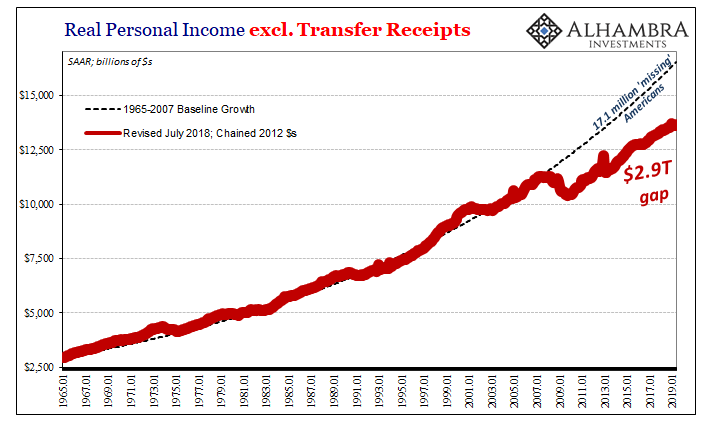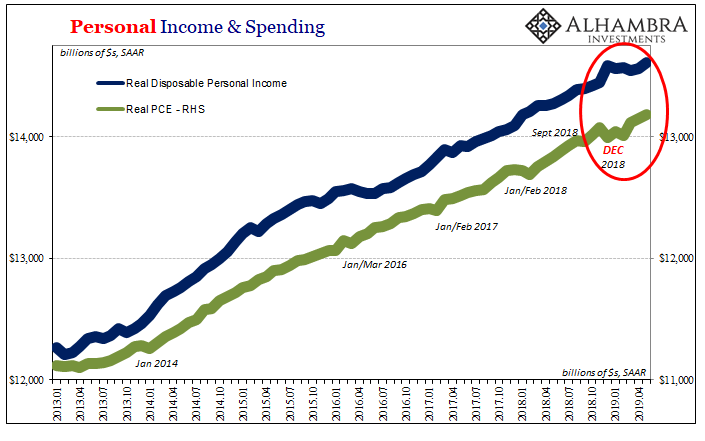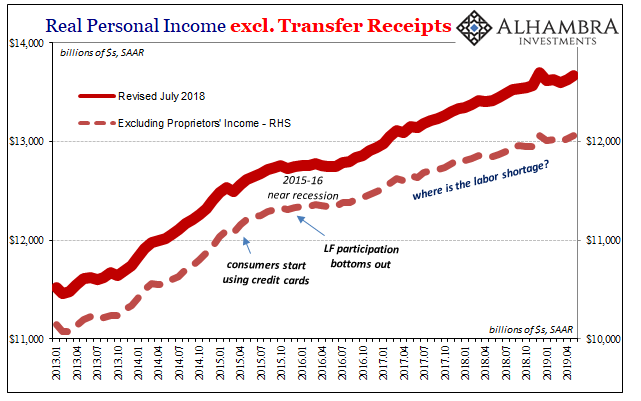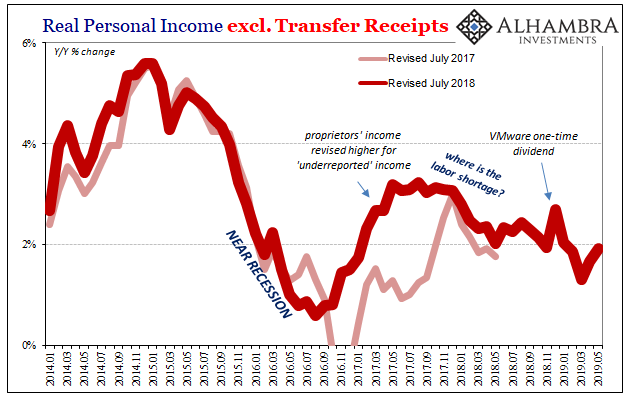With the Democratic Party staging the first of its national debates, The New York Times found time to embed a reporter amongst a group of Trump voters in the swing state of Michigan. Situated to watch the show, and given how the election of 2016 turned out, the Rust Belt is on the minds of both parties. It doesn’t seem, though, as if either can really access the energy motivating rather more fluid voting blocs.
Candidate Trump won by saying the unemployment rate was fake; thereby touching a nerve unspoken outside of America’s workforce. It has manifested in several ways during his first term, but the most interesting (I would say regretful) dynamic has been his total embrace of the same economic metric he once ruthlessly mocked.
From an inside perspective, it’s an easy sell. The unemployment rate is at a 50-year low. There’s your economy; give me four more years.
Except, no. Rather than being a full-on deterrent, the unemployment rate is merely deflecting the still roiling dissatisfaction in even more extreme ways. These were on full display during the Dems debate. One Republican Michigander’s response picked up on both sides:
And Tony Lorentz, an auctioneer, who was the closest to the kind of Trump supporter that journalists tend to find at diner counters, mocked Democrats’ promised programs for tuition-free college and “Medicare for all.”
“Free, free,” he said. “What happens when they run out of free?”
The “other” side (it goes both ways) always tends to argue the effect without taking much or enough account of the cause. As one other attendee said in light of some strong language from Elizabeth Warren on the subject of wealth inequality, “I don’t know, we have the lowest black unemployment.”
The economy is booming, yet half the country wants free stuff. The other half calls them lazy socialists without really wondering if they have a more developed purpose than the late embrace of blanket socialism. And then they demand trade wars without internalizing why they might.
I seek no entry into partisan politics here. Making no endorsement one way or another, my own purpose is instead to urge understanding especially about what might be animating either intense group. The unemployment rate isn’t signaling our salvation, it is the cause of so much of the populist revolt.
It’s the biggest misunderstanding in modern times.

That one labor statistic says that what you see above is the absolute best that could have been done by anyone – from elected politicians to unelected and unaccountable bureaucrats whose independence has meant they’ve crowned themselves the final judge and jury on all things with the economy. And since those very same central bankers have also been appointed economic stewards, you don’t need to guess how many straight A’s have been filed on their report cards.
As I’ve done before, all it takes is a little context for one’s entire understanding (of either brand of dissatisfaction) to make more than inconvenient political sense. The whole picture, the entire meaning of the current atmosphere changes by adding one small frame of reference. From “I can’t understand all the fuss” to clearly appreciating the urgency in the blink of an eye.

According to the latest estimates by the Bureau of Economic Analysis, total income was $13.67 trillion in May 2019 (seasonally-adjusted annual rate). Had the Great “Recession” actually been a recession, total income would have been $16.53 trillion. That “missing” nearly $3 trillion is simply too incomprehensible. There’s no need to pay off everyone’s student loans in that economy.
And it stands in total contrast to the unemployment rate. Yet, it is actually the one behind each political group’s activities and beliefs (currently).
In that gap, not only are there Americans who can’t work (because, contrary to the wage argument put forth by central bankers, there isn’t near enough demand for labor) there are many times more who are stuck without much opportunity to go farther. Losing any realistic path for advancement can radicalize anyone’s political view as much as being left out of work.
Seeing it this way, you might better understand “free, free.” When everyone on the internet says the economy is booming but you can’t see it anywhere, it’s easy to conclude the entire system must be rigged. Once you get that far, you aren’t looking to fine tune solutions, you seek out the closest demagogue to how far you want to blow up the established paradigm.
And we haven’t even gotten to the next one yet. There’s all this misplaced anger already, and Euro$ #4 isn’t even that far into the US economy.
That’s the other bad news in the latest monthly results on Personal Income and Spending. Not only are American workers about $3 trillion behind in income to this point, it increasingly looks like that gap is about to grow much wider.



Since late last year (the landmine), income growth has softened more than it already had from when the first signs of Euro$ #4 were detected at the end of 2017 and beginning of 2018. Growth is now about where it was in the fuller downswing of Euro$ #3, the near recession of 2015-16.
The curves all say there is (a lot) more of this to come.
The Election of 2020 promises to be heated no matter what. Still, the political and social temperature might helpfully be lowered if there were to be bipartisan agreement that the “free, free” side had a point about the need for some kind of relief (each still reserving the right to debate and argue about exactly what form) and the “America first” side at least had an equally valid point about the plight of American workers.
Both polar opposites actually stem from the same damn problem. That’s the real tragedy here, the curse of the unemployment rate. For both sides (including the D’s who are now arguing with the R’s over which side is responsible for these “good times”), neither can look at these obvious economic insecurities and place them in their proper context.
Even though all it takes is one little dotted line.

Stay In Touch